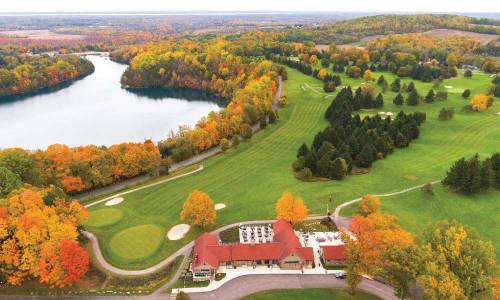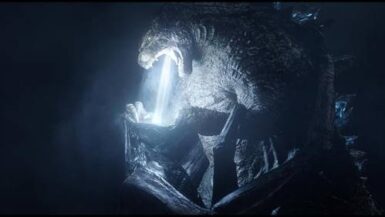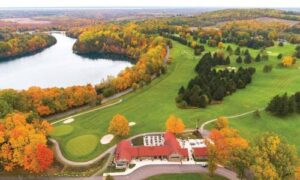
The JIG is up Green Lakes
Welcome to the JIG – Jay’s Insider Guide – where he breaks down golf courses like a fraction for you. Knowledge is power, and forewarned is forearmed. The JIG is your study guide and ideas for a game plan. All you need to do is execute.
This episode – GREEN LAKES GOLF COURSE
—by Jay Flemma, Special to the clubs of the New Jersey Ski Council—
FAYETTEVILLE, NY – Call this place Baby Bethpage for two reasons. First, like Bethpage Black, Green Lakes is a beloved municipal facility with decades of history and strong architectural pedigree; it is one of the earliest designs of the preeminent golf course architect Robert Trent Jones, Sr. Second, the course superintendent, Kevin Carroll, was second in command at Bethpage Black for both the 2002 and 2009 U.S. Opens. Rest assured: the course will be in phenomenal condition.
Green Lakes is a milk run, a chance for a golfer to post their best score of the year. There are few forced carries off the tee or into greens. The greens, while curvaceous, are not so wild as to dish out countless 3-putts. And the bunkering, in places, is so low you can use a putter to play out of them and on to the greens.
Green Lakes’ routing of the golf holes results in a rhythmic tempo to the round: attack, lay back, attack, lay back, etc. No matter what, even after a set-back or a bad hole, there is always time to attack and recover at Green Lakes. An aggressive attitude – being mindful of the few places to tread carefully – will result in a good score.
Holes 1-6 – ATTACK, ATTACK, ATTACK. There are three par-3s in the opening six holes – numbers two, four, and six – none of which are over 190 yards from the regulation tees. The only danger spots are a) the devilishly contoured first green with its severe back to front slope and crescent shaped-front around a center-line bunker, and b) the tee shots on three and five – two long, tree-lined par-4s.
Holes 7-9 – TREAD CONSERVATIVELY, AVOID THE BIG MISTAKE. Even a great start can result in a disappointing front nine score in a hurry, as two tricky par-5s sandwich one of the toughest par-4s on the course.

Seven is one of the coolest tee shots anywhere in golf as a fairway indentation known as “the Catcher’s Mitt” awaits in the middle of the dog-leg, right where an optimum drive might land. Golfers must play around, over, or through the Catcher’s Mitt while avoiding the trees that stand sentinel on both sides of the fairway.
The terrain of the eighth fairway is among the most severe on the course as both tee shots and approaches will carom sharply right. Also beware the severe false front that will send short pitches and chips back to your feet. The iconic par-5 ninth plays all the way back up the hill to the clubhouse where a new, larger green awaits, but with a devilish false side that, like the fairway, will send golf balls scurrying off the green and into the rough on the right. Oh, and try not to slice OB into the road off the tee.
Hole 10 – GREEN LIGHT. The short par-5 10th is the greenest of Green Lakes’ Green Light Districts. Average golfers can reach the green in two good shots, perhaps needing only a long iron or hybrid for the second. Severe mounding around the greens again places a premium on a solid short game, but it’s a golfer’s best chance for a birdie or even an eagle all day.
11-13 – THE GAUNTLET OF THE BACK NINE. Quintessential Syracuse newscaster Matt Mulcahy calls these holes the toughest on the course, and he’s correct. 11 is textbook Jones from the olden days: a long tee shot to the knee of the dog-leg, then a carry over a ravine to a pedestal green offset at an angle, arguably the most difficult par-4 on the golf course. The 12th is doubtless the hardest par-5 on the golf course. Once again, the terrain is the defense as everything slopes hard…HARD!…right on both the second shot and the approach. The par-3 13th features an uphill long or mid-iron to a green partially hidden from view and defended by deep bunkers short and right. This is Green Lakes’s proper rejoinder to Augusta National’s Amen Corner. (Interestingly, it occurs at the same sequencing of holes.)
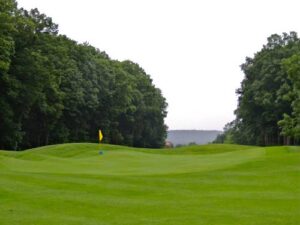
14-17 – CHAAAAAAAAARRRRRRGGGE. Here’s your chance to be Jack Nicklaus or Rory McIlroy and put on a late rally! Three short par-4s and a middle-length par-3, all of which are gettable, means it’s time to hit the gas big time and go low. The main defenses at 14, 15, and 17 – all short par-4s – are the green contours. 14 is actually just a drive and pitch. Even if your round thus far has been crappy all day, you can make up a lot of ground in a hurry.
18 – EVERYTHING RIDES ON THE TEE SHOT. A truly great 18th hole is supposed to be a summation of all that you’ve seen before. 18 at Green Lakes doesn’t quite do that. Instead, it throws a knuckleball at you. The holes curves hard left like a scimitar through a thin chute of trees. It’s one thing to demand your best drive of the day at 18, but this requires pin point accuracy, particularly rewarding people who can control a hard draw. The knee of the dog-leg is awkward, and the green sits obliquely to the line of play, requiring an uphill approach over a bunker. For the average golfer, this could be the most difficult green to hit in regulation.
FINAL THOUGHTS AND INSIDER TIPS
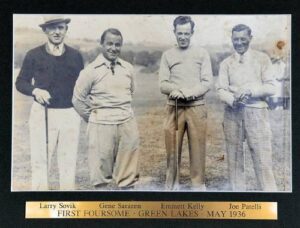
Practice your chipping and putting, there is a premium on the short game as length is not an issue at Green Lakes. For those of you interested in learning more abut the course’s history, all of Robert Trent Jones’s papers and collected architectural materials are contained in the Cornell University Library.
JEFF CARSON, PGA HEAD PROFESSIONAL – The test of this golf course is the terrain and the undulations. There are no water hazards; you’ll likely finish your round with the same ball you started with.
I divide the golf course into three six-hole segments: the first six holes can be fairly tough, but 7-12 you have four par-5s and can make up ground, then 13-18 have risk-reward holes where there are interesting strategic decisions. Those holes really make you think. Bust driver on the short par-4s or lay-up to 100 yards? Your choice.
Finally, never never never miss left off the tee on this golf course. Left off the tee finds all kinds of trouble, everywhere except number nine. There are no happy hookers at Green Lakes. Finally, most putts break towards the lake.
KEVIN CARROLL, HEAD COURSE SUPERINTENDENT – Enjoy this routing while you have the chance, because we are reversing the nines next year. We found an old scorecard with that configuration that we think is signed by Sam Snead himself. By the way, the Catcher’s Mitt used to be a bunker; we have the satellite photos from 1938. There was also a bunker on the knee of the dog-leg on eight.
You need to go after the par-5s – seven and 10, play for birdie – and yes, play it safe at 11 and 12.
BOBBY JONES, JR. – Back during the Depression, my father helped operate the club for his fee under a company called Green Lakes Construction. It was always one of his favorites, and he spoke highly of it.


